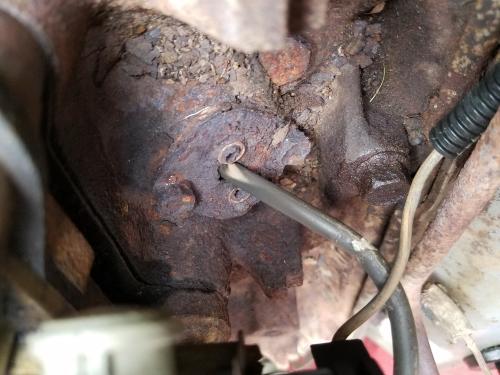Search Forum
Mystery Components
|
I'm sure this is an easy answer for most on this forum. I have two components that I'm curious about.
The first is in the PCV hose between the PCV valve and the carb (I believe). Looks like maybe some sort of temperature regulated valve. The second is a metal tube between the intake manifold and the carb. It's located under the carb on the passenger side. Engine is a 460. Thanks in advance!   Sorry that the pics aren't rotated properly. They appear properly in every other application that I view them with.
THE BEAST - '85 F350 2WD (non dually) Crew Cab, 460 carbureted, C6 tranny
|
|
Administrator
|
First item is an air valve, used on A/C equipt vehicles to admit extra air into the intake under high temperature conditions, it is thermally controlled by a bimetal spring. Second was your choke hot air tube, but most of these engines didn't use a hot air choke, it was electric heated by the 7 volt stator feed from the alternator.
Bill AKA "LOBO" Profile
"Getting old is inevitable, growing up is optional" Darth Vader 1986 F350 460 converted to MAF/SEFI, E4OD 12X3 1/2 rear brakes, traction loc 3:55 gear, 160 amp 3G alternator Wife's 2011 Flex Limited Daily Driver 2009 Flex Limited with factory tow package Project car 1986 Chrysler LeBaron convertible 2.2L Turbo II, modified A413 |
|
This post was updated on .
In reply to this post by baddog8it
The first component is called a Hot Idle Compensator Valve (HICV on your emissions diagram.)
When the engine is hot, the air/fuel mixture is richer than normal. The HICV opens slightly to let in a little bit of air into the intake and below the throttle valve to lean out the mixture at idle to compensate for the richer mixture. The second component looks like a broken choke tube. Most Fords of this era used a thermostatic choke with electric assist. If that plate is bolted to the intake manifold, a tube was originally inserted in it to operate the choke. One end serves as a fresh air tube that connects to the carburetor air horn, the other a hot air tube that screws onto the choke assembly. The choke works in lockstep with the coolant temperature. As the coolant heats up, the tube also heats up and begins to open the choke. Full operating temperature = fully opened choke. (Small block engines used a chamber on the passenger's side exhaust manifold and uses the temperature of the exhaust to accomplish the same thing.) You should also have a wire connecting the choke cap to the back of the alternator. That would be the electric assist. It only works above about 60 degrees to help the choke come off faster. If the thermostatic choke isn't hooked up properly, you will have cold start problems if it temperatures are less than 60 degrees.
Lucille: 1985 Ford F150 XLT Lariat
*Colors: Dark Canyon Red exterior, Canyon Red interior *Engine: 5.0, CompCams 31-230-3, "Thumper" E7 heads, Edelbrock Performer intake, Autolite 4100 carburetor, DuraSpark II ignition, Thorley Tri-Y headers, Flowmaster dual exhaust, H-pipe. *Drivetrain: AOD transmission, 3.55 gears, 2wd. |
|
Thank you both - great info!
I do have a loose wire bouncing around in that general area, and now that the weather is getting colder THE BEAST doesn't like running much until she warms up. Now I know what to look for.
THE BEAST - '85 F350 2WD (non dually) Crew Cab, 460 carbureted, C6 tranny
|
Bullnose Enthusiasts Forum
|
1 view|%1 views
| Edit this page |

